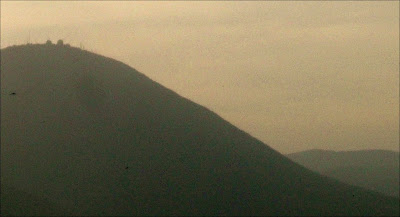 A local settlement fence with motion sensors. Behind the fence lies the sprawling Arab village of Deir Dibwan.
A local settlement fence with motion sensors. Behind the fence lies the sprawling Arab village of Deir Dibwan. Every fence that Israel erects comes with philosophical and emotional baggage. For most Israelis, the construction of the massive wall is strictly a life-saving security consideration. But as a religious settlement, with inhabitants from every Jewish group from the National Religious to the Hareidi (ultra orthodox,) the residents of Kochav Ya'akov have to weigh the Jewish arguments of fence building as well. On the one hand, it is a basic point of Torah that one must protect one's own life at most (but not all) costs. Motion sensors and barbed wire certainly delay the potential infiltrator, possibly long enough to get a security team on the scene to finish him off. Of course, even during the intifada, there was not a single attempted infiltration here, but that's not to say that it couldn't happen.

But what about the biblical injunction to settle the land of Israel? While the municipal jurisdiction of Kochav Ya'akov extends for miles, a fence surrounding the entire land area would break the army's budget. Therefore, the fence had to be built short and tight, surrounding only the existing houses, with most of Kochav Ya'akov's land outside. This sends the psychological message to the neighboring Arabs that the Jews have given up. Building and land ownership laws throughout Israel, and especially in Judea and Samaria, are only enforced against Jews. Government fears of "making a scene" for CNN with demolition of illegal structures, a left-wing infantilizing pity towards the Arabs powerful enough to pardon all crimes, and a general post-Zionist apathy amongst middle-of-the-road Israelis has infected the nation's decision-makers. With a fence marking the new, truncated limits of the settlements, no law enforcement, a legal shield and publicity from Peace Now and other advocacy groups, the surrounding villagers are free to take as much land as they please.
This is not to mention the psychological victory fence-building grants Israel's adversaries. True that a fence may stop a terrorist, but it also sends a signal of victory. A fence broadcasts fear to the potential killers, and the sadistic infliction of fear and pain is the life-blood of terrorism. Building fences may actually inspire more attacks than the they thwarts.
Next: moving beyond the fence.















































